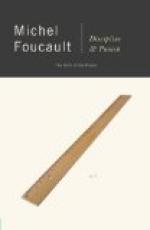|
This section contains 1,651 words (approx. 5 pages at 400 words per page) |

|
Summary
Foucault begins the section entitled, “Illegalities and delinquency” with the contention that incarceration is not just a denial of liberty, but a “technical project,” a disciplinary and reformative mechanism. The symbol that indicates the transition between public executions and the modern penal system is the 1837 replacement of the chain-gang with the police carriage. The processional nature of the chain-gang made it a public spectacle, which became difficult for the police to control due to the disorderliness of observers. Prisoners in the chain-gang began to develop popular support from spectators for providing a “symbolic outlet” for the lower classes to express their resentment toward authorities (262). Consequently, the chain-gang was replaced by a police carriage, “a moving prison,” where the prisoners could be observed by administrators, just like the Panopticon (263).
Bizarrely, the development of the prison does not follow a linear chronology; despite its prevalence...
(read more from the Section 4, Part 2 Summary)
|
This section contains 1,651 words (approx. 5 pages at 400 words per page) |

|




